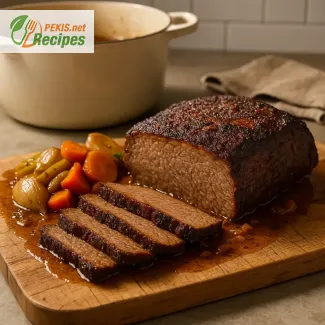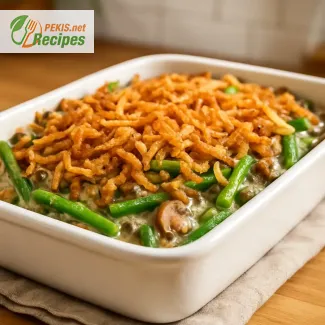
Mastering the Art of Slow-Cooked Brisket for Perfect Flavor
Discover the timeless technique behind ultra-tender beef brisket
Preparing an authentic beef brisket is more than just cooking—it’s a culinary tradition rooted in slow cooking, patience, and the perfect balance of flavors. This classic dish, prized for its juicy texture and rich beefy flavor, has found its way into backyard barbecues, gourmet kitchens, and home ovens worldwide. Whether you're making it for a family gathering or a weekend indulgence, this guide takes you through the essential foundations of making slow-cooked beef brisket that melts in your mouth.
What makes brisket a cut above?
The beef brisket comes from the lower chest of the cow, a muscular, collagen-rich cut that becomes incredibly tender when cooked low and slow. This unique composition means brisket isn't suited for quick cooking methods—instead, it rewards those who take their time. When braised or roasted at a low temperature, the connective tissue breaks down, yielding succulent meat with deep, complex flavors.
There are two main sections of the brisket: the flat cut, which is leaner and slices well, and the point cut, which is fattier and more flavorful. For home cooks aiming for a balance of both, a whole brisket (also called a “packer cut”) is ideal. It's crucial to select a well-marbled piece, as the fat renders slowly during cooking, infusing the meat with natural moisture and flavor.
Choosing your method: oven vs. smoker vs. slow cooker
One of the reasons brisket is so beloved is its versatility in preparation. Whether you’re using a traditional oven, a smoker, or a slow cooker, the goal remains the same: break down the muscle fibers gradually to achieve fork-tender results.
- In the oven, brisket roasts gently for several hours. When wrapped in foil or placed in a Dutch oven with a rich braising liquid, it creates a steamy environment that locks in moisture and flavor.
- In a smoker, brisket absorbs a deeper, more complex taste. Smoking low and slow over wood chips imparts a characteristic bark and smoke ring prized in Texas-style barbecue.
- A slow cooker offers convenience and consistency. With minimal prep, you can set it and forget it, allowing the meat to tenderize over the course of the day.
Each method delivers a different texture and flavor profile, but all reward your patience with a satisfying, hearty dish.
The key ingredients for a standout brisket
While brisket recipes vary around the world, most successful versions share several essential elements. Dry rubs, typically made with a mix of salt, pepper, paprika, garlic powder, and onion powder, build a flavorful crust. Some cooks enhance depth with brown sugar, cayenne, or mustard powder.
For braised brisket, aromatic vegetables like onions, carrots, and celery, along with beef stock, red wine, or tomato paste, create a flavorful base. Low, steady heat allows these ingredients to meld and penetrate the meat, adding complexity with every hour.
Resting time is equally crucial. After cooking, brisket should sit covered for at least 30 minutes. This lets the juices redistribute and ensures each slice is tender and moist.
When and how to serve slow-cooked brisket
Beef brisket is incredibly adaptable in serving style. For traditional comfort food, pair it with mashed potatoes, roasted vegetables, or buttery polenta. For a festive twist, slice it thinly for brisket sandwiches with pickles and slaw, or serve it taco-style with warm tortillas and fresh herbs.
Leftovers are prized for their richness and versatility. Cold brisket can be repurposed in sandwiches or chopped and reheated in hash, stews, or grain bowls.
Common mistakes to avoid when cooking brisket
Because brisket requires patience and care, rushing the process often leads to disappointment. Avoid the temptation to crank up the heat—high temperatures will toughen the meat and dry it out. Also, resist slicing it too early; cutting brisket before it rests will let the juices escape, leaving the meat dry.
Skipping the fat trimming step is another pitfall. While fat is essential for moisture and flavor, too much surface fat can result in a greasy finish. Aim to leave a thin, even layer to baste the meat naturally during cooking.
Lastly, make sure to slice against the grain. This shortens the muscle fibers in each piece, resulting in that coveted tender texture.
Why brisket has become a culinary icon
Across cultures, beef brisket has become synonymous with celebration and comfort. From Jewish holiday tables to American smokehouses, brisket continues to earn its place as a dish worthy of time, tradition, and technique. It embodies the idea that flavor develops slowly, and that true satisfaction lies in the process as much as the result.
Preparing brisket isn't just about following steps—it's about embracing a slow-cooked philosophy that values richness, patience, and simplicity done well. Whether you're a beginner or a seasoned cook, this dish promises a rewarding journey from preparation to plate.
- Prepare the brisket:
Pat the beef brisket dry with a paper towel. Trim excess surface fat, leaving a thin layer for flavor and moisture. Mix the salt, pepper, paprika, garlic powder, onion powder, and brown sugar. Rub the spice blend evenly over the brisket and let it sit at room temperature for 20 minutes. - Sear the meat:
In a large Dutch oven or heavy roasting pan, heat olive oil (30 ml / 2 tbsp) over medium-high heat. Sear the brisket on all sides until browned, about 3–4 minutes per side. Remove the meat and set aside. - Sauté the vegetables:
In the same pot, add chopped onions, carrots, and celery. Cook for 5–7 minutes until softened. Stir in minced garlic and tomato paste and cook for 2 minutes more to deepen the flavor. - Deglaze and braise:
Pour in red wine to deglaze the pot, scraping up the brown bits with a wooden spoon. Cook for 3 minutes, then return the brisket to the pot. Add beef stock, Dijon mustard, bay leaves, and thyme. The liquid should come halfway up the meat—add water if needed. Cover with a lid or foil. - Slow cook:
Preheat the oven to 150 °C (300 °F). Place the covered brisket in the oven and cook for 3.5 hours, checking once or twice to spoon braising liquid over the meat. - Rest and slice:
Remove the brisket from the oven and let it rest, covered, for 30 minutes. Transfer to a cutting board and slice against the grain into 1 cm (½ inch) slices for maximum tenderness. - Serve:
Serve with spoonfuls of braising liquid and vegetables. Ideal with mashed potatoes, roasted vegetables, or warm polenta.
Enhancing Your Homemade Brisket with Flavorful Innovations
Expert-level strategies to take your slow-cooked brisket to the next level
Mastering a traditional beef brisket is a culinary triumph, but with a few thoughtful adjustments, it’s possible to elevate this comforting dish into something even more flavorful, healthier, or better suited to your preferences. From seasoning choices to cooking techniques, small changes can dramatically enhance the final result. This guide explores ways to refine the recipe without compromising its soul.
Flavor-enhancing ingredient swaps and additions
To deepen the umami flavor of your brisket, consider incorporating a tablespoon of Worcestershire sauce or soy sauce into the braising liquid. These ingredients add savory complexity and can subtly enhance the beef’s natural richness. Another excellent addition is anchovy paste—while it doesn’t add fishy flavor, it contributes an underlying depth that boosts the entire dish.
Using bone broth instead of regular beef stock can improve both the flavor and the nutritional profile. Bone broth brings extra collagen, giving the sauce a silkier mouthfeel and the meat a more luxurious coating.
If you're aiming for a sweet-smoky balance, adding molasses, balsamic vinegar, or a touch of liquid smoke can introduce more complexity. Each offers a unique layer of taste without overpowering the dish. Chili flakes or a dash of chipotle powder can also bring warmth without turning the brisket spicy.
The advantage of homemade over store-bought
Preparing brisket at home not only ensures superior ingredient quality but also gives you full control over flavor, texture, and dietary concerns. Unlike many pre-cooked or deli brisket options, which are often over-salted and include preservatives, a homemade version is cleaner and more customizable.
Homemade brisket can also be tailored to suit specific health goals. For example, you can control the amount of added sugar, reduce sodium, or choose organic and grass-fed beef. You also avoid artificial flavor enhancers that are common in processed meat.
Beyond nutrition, the satisfaction of crafting a perfectly slow-cooked brisket with your own seasoning profile creates a deeper connection with the food—making it not just a meal, but an experience.
Common mistakes to avoid
The most frequent error with brisket is undercooking or overcooking. Undercooked brisket remains chewy, while overcooked brisket falls apart into mush. The key is low and consistent temperature with sufficient moisture. Checking too often or opening the oven door repeatedly disrupts the heat and extends cooking time.
Another mistake is skipping the resting period. Slicing too soon after cooking causes valuable juices to escape, drying out the meat. Always let the brisket rest under foil for at least 30 minutes.
Improper slicing also affects tenderness. Brisket should be sliced against the grain to shorten muscle fibers and make each bite softer. Many first-time cooks slice with the grain, resulting in a stringy texture.
Lastly, avoid overloading the braising liquid with too many flavors. A harmonious blend of aromatics and seasoning is key—overcomplicating the mix can muddy the final taste.
Making the recipe healthier without losing flavor
If you're looking to reduce the fat content, you can trim the brisket more aggressively before cooking. However, leave at least a thin layer of fat to preserve moisture and richness. Another strategy is to refrigerate the cooked brisket overnight and remove the solidified fat from the surface before reheating.
Swap brown sugar for a smaller amount of pure maple syrup or date paste to achieve sweetness without refined sugar. You can also bulk up the vegetable content with additional leeks, parsnips, or mushrooms, which not only enhance nutrition but also add earthy undertones to the dish.
For lower sodium, use low-salt stock and scale back on added salt, compensating with herbs like rosemary, thyme, or oregano, which boost flavor naturally.
How to tailor brisket to personal preferences
Brisket is incredibly adaptable. For a Mediterranean twist, add rosemary, olives, and sun-dried tomatoes to the braising liquid. If you prefer a Middle Eastern profile, spice it with cinnamon, coriander, and a splash of pomegranate molasses.
To make the dish gluten-free, ensure your mustard and stock are free of thickeners containing wheat. You can also thicken the sauce with cornstarch slurry or arrowroot powder instead of flour.
For a brighter flavor profile, finish the dish with a squeeze of lemon juice or a sprinkle of fresh parsley before serving. It cuts through the richness and enhances the overall aroma.
Creating memorable variations for different occasions
For holidays or dinner parties, consider glazing the brisket with a reduction of the braising liquid combined with cranberry jam or apricot preserves. This technique adds a sweet-savory balance and makes the presentation more festive.
For leftovers, shred the brisket and serve it in tortillas, use it in risotto, or stir it into grain bowls with roasted vegetables. A few pickled onions or a yogurt-based sauce can brighten up the flavor and transform the dish entirely.
These creative tweaks ensure that your brisket never feels repetitive, no matter how often you make it.
Allergens present in the recipe:
- Celery
- Mustard
- Potential traces of sulfites in red wine and beef stock
How to eliminate allergens and gluten:
- Replace Dijon mustard with a mustard-free herb paste (e.g. parsley and garlic).
- Use celery-free stock and replace celery with fennel bulb for similar aroma.
- Choose gluten-free beef stock and mustard without any thickening agents or wheat-based additives.
Vitamins and minerals per serving (approximate):
- Vitamin B12: 3.2 µg – Supports red blood cell production and nervous system health
- Iron: 4.6 mg – Helps prevent fatigue and supports oxygen transport
- Zinc: 7 mg – Boosts immunity and wound healing
- Vitamin A: 1900 IU – Essential for eye health and immune function
- Potassium: 780 mg – Regulates fluid balance and muscle contractions
- Vitamin C: 8 mg – Antioxidant, supports skin health and immunity
Antioxidants per serving (approximate):
- Lycopene (from tomato paste): 1.8 mg – May reduce oxidative stress and support heart health
- Polyphenols (from red wine): 50–100 mg – Support vascular health and anti-inflammatory function
- Flavonoids (from onions and garlic): 20–30 mg – May protect against cellular damage and support detoxification pathways





